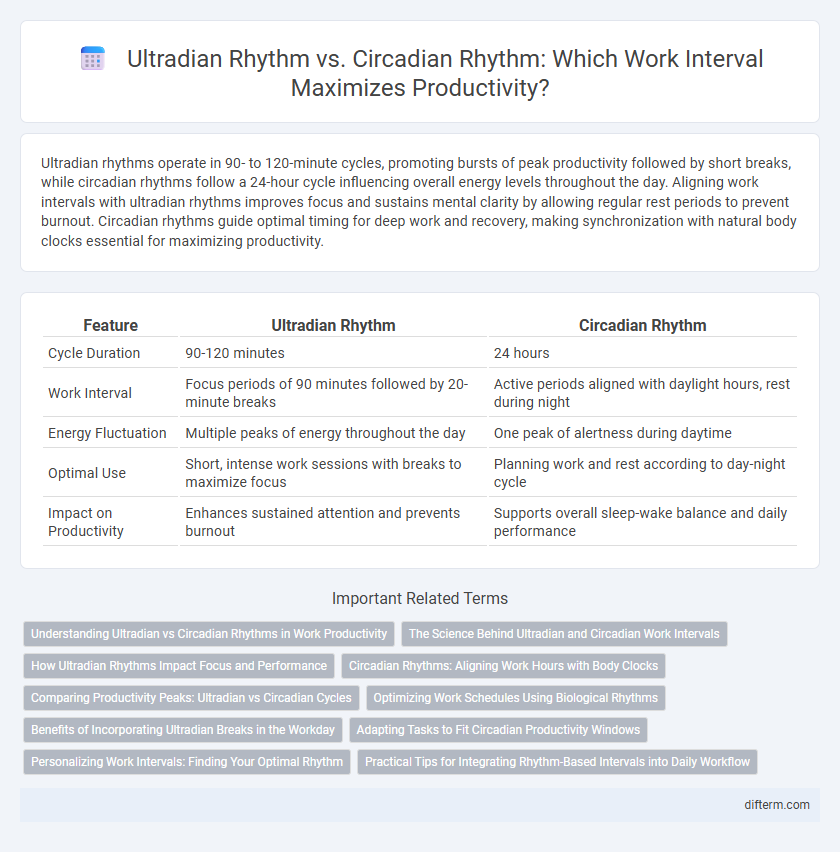Ultradian rhythms operate in 90- to 120-minute cycles, promoting bursts of peak productivity followed by short breaks, while circadian rhythms follow a 24-hour cycle influencing overall energy levels throughout the day. Aligning work intervals with ultradian rhythms improves focus and sustains mental clarity by allowing regular rest periods to prevent burnout. Circadian rhythms guide optimal timing for deep work and recovery, making synchronization with natural body clocks essential for maximizing productivity.
Table of Comparison
| Feature | Ultradian Rhythm | Circadian Rhythm |
|---|---|---|
| Cycle Duration | 90-120 minutes | 24 hours |
| Work Interval | Focus periods of 90 minutes followed by 20-minute breaks | Active periods aligned with daylight hours, rest during night |
| Energy Fluctuation | Multiple peaks of energy throughout the day | One peak of alertness during daytime |
| Optimal Use | Short, intense work sessions with breaks to maximize focus | Planning work and rest according to day-night cycle |
| Impact on Productivity | Enhances sustained attention and prevents burnout | Supports overall sleep-wake balance and daily performance |
Understanding Ultradian vs Circadian Rhythms in Work Productivity
Ultradian rhythms are biological cycles lasting 90-120 minutes that regulate focus and energy levels during work, promoting optimal productivity through intervals of intense activity followed by brief rest. Circadian rhythms, on the other hand, operate on a 24-hour cycle influencing overall alertness and cognitive function throughout the day, aligning work tasks with peak energy periods like mid-morning or early evening. Understanding these rhythms enables employees to schedule tasks according to natural energy fluctuations, enhancing sustained concentration and reducing burnout.
The Science Behind Ultradian and Circadian Work Intervals
Ultradian rhythms, occurring approximately every 90-120 minutes, regulate cycles of heightened alertness and cognitive performance, suggesting work intervals aligned with these natural peaks can enhance productivity. Circadian rhythms follow a roughly 24-hour cycle influencing sleep-wake patterns and energy levels, making alignment of work schedules with circadian peaks crucial for sustained focus. Scientific studies reveal that synchronizing tasks with ultradian and circadian rhythms optimizes cognitive function, reduces fatigue, and improves overall work efficiency.
How Ultradian Rhythms Impact Focus and Performance
Ultradian rhythms regulate cycles of approximately 90 to 120 minutes, influencing periods of high and low alertness that directly impact focus and performance during work intervals. Aligning tasks with these natural peaks enhances cognitive function, allowing for sustained concentration and improved productivity before a brief rest period is necessary. Understanding and leveraging ultradian rhythms can optimize work efficiency by matching work intensity with the body's innate energy fluctuations.
Circadian Rhythms: Aligning Work Hours with Body Clocks
Circadian rhythms regulate the body's natural energy peaks and troughs over a 24-hour cycle, making alignment of work hours with these cycles crucial for maximizing productivity. Research indicates that scheduling demanding tasks during peak cognitive times, typically mid-morning and early evening, enhances focus and efficiency. Adjusting work patterns to individual circadian rhythms can reduce fatigue, improve mental clarity, and increase overall work output.
Comparing Productivity Peaks: Ultradian vs Circadian Cycles
Ultradian rhythms cycle approximately every 90 to 120 minutes, leading to multiple productivity peaks throughout the day, enabling focused work intervals followed by short breaks to optimize mental performance. Circadian rhythms operate on a roughly 24-hour cycle, influencing broader energy fluctuations with peak cognitive function typically occurring mid-morning and early evening. Understanding the interplay between ultradian and circadian cycles allows for scheduling work sessions that maximize alertness while minimizing burnout, leveraging both short-term focus and long-term daily energy patterns.
Optimizing Work Schedules Using Biological Rhythms
Optimizing work schedules by aligning tasks with ultradian and circadian rhythms enhances productivity and mental focus. Ultradian rhythms, occurring every 90-120 minutes, suggest working in focused intervals followed by short breaks to prevent burnout and maintain energy. Circadian rhythms guide the timing of more demanding tasks during peak alertness periods, typically mid-morning and early evening, maximizing cognitive performance throughout the workday.
Benefits of Incorporating Ultradian Breaks in the Workday
Incorporating ultradian breaks, typically every 90-120 minutes, leverages the body's natural energy cycles to enhance focus and reduce fatigue during work intervals. This approach aligns with the ultradian rhythm's 90-minute productivity peaks, leading to improved concentration and greater mental clarity compared to relying solely on circadian rhythm-based scheduling. Employees who adopt ultradian breaks report increased sustained productivity, decreased burnout, and more consistent output throughout the workday.
Adapting Tasks to Fit Circadian Productivity Windows
Adapting tasks to fit circadian productivity windows involves aligning work periods with natural peaks in alertness that typically occur mid-morning and early evening. Ultradian rhythms, which cycle every 90-120 minutes, dictate shorter bursts of intense focus followed by brief recovery breaks, optimizing sustained productivity. Structuring tasks to match these biological intervals reduces cognitive fatigue and enhances work efficiency throughout the day.
Personalizing Work Intervals: Finding Your Optimal Rhythm
Ultradian rhythms, occurring in 90- to 120-minute cycles, guide natural fluctuations in focus and energy, making them crucial for optimizing work intervals beyond the traditional 8-hour circadian framework. Personalizing work periods by aligning tasks with these shorter, high-energy phases enhances productivity and reduces burnout. Understanding your unique ultradian pattern enables strategic breaks and peak performance windows tailored to your body's natural rhythm.
Practical Tips for Integrating Rhythm-Based Intervals into Daily Workflow
Ultradian rhythm work intervals typically span 90 to 120 minutes, matching natural energy peaks for enhanced focus and productivity. Implementing short 5 to 20-minute breaks between these cycles helps prevent burnout and sustains mental clarity throughout the day. Aligning tasks with circadian rhythm phases, such as scheduling challenging work during peak morning alertness and routine tasks during afternoon energy dips, optimizes overall workflow efficiency.
Ultradian Rhythm vs Circadian Rhythm (work intervals) Infographic

 difterm.com
difterm.com